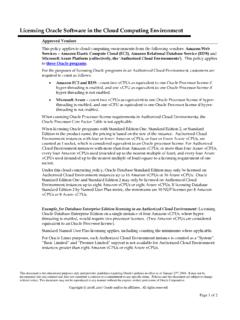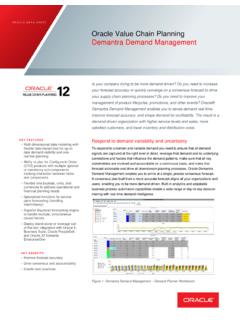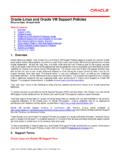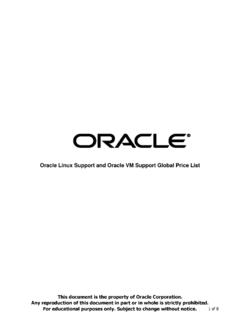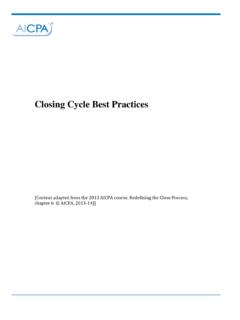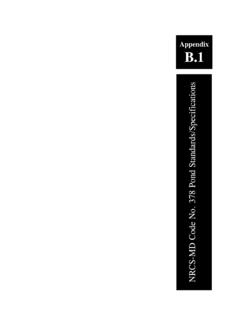Transcription of Oracle Supply Planning Cloud
1 1 DATA SHEET | Oracle Cloud Supply Planning | Update 21A Copyright 2021, Oracle and/or its affiliates Oracle Cloud Supply Planning Oracle Cloud Supply Planning gives you simpler, faster, and better ways to plan and execute your operations strategy. It detects material and capacity constraints, prioritizes competing demands, and intelligently reroutes global Supply to minimize disruptions. It also helps you schedule production to make the best use of your factory resources. Take advantage of opportunities as they occur with more agile, iterative Supply Planning in the Cloud . PLAN GLOBAL Supply Today s Supply chains are complex, with multiple tiers of internal and external nodes. You must plan for a global network of in-house production and distribution facilities, contract manufacturers, drop ship suppliers, and outside services providers.
2 In addition, you may need to manage discrete, process, and configure-to-order manufacturing processes. Figure 1. Quickly respond to changes in Supply and demand across global networks Capabilities Plan your global Supply chain across multiple tiers, including outsourced manufacturing and upstream suppliers including outsourced manufacturing and upstream suppliers Plan process, discrete, and mixed-mode manufacturing Supply Schedule your factory operations considering production constraints Dynamically prioritize and reschedule demands based upon business requirements Automatically evaluate material and capacity constraints, determine root causes, and recommend actions Model what-if changes to capacity, demand, Supply , and items Compare the effectiveness of alternative plans Release the best plan for execution and cancel or reschedule Supply orders as needed 2 DATA SHEET | Oracle Cloud Supply Planning | Update 21A Copyright 2021, Oracle and/or its affiliates Oracle Cloud Supply Planning accounts for lead times, shipping and receiving calendars, as well as material and capacity constraints across your extended Supply chain so you know when you can realistically meet demand.
3 With its comprehensive network and sourcing model, you can trade off internal vs. external production capacity, configure drop ship relationships, consolidate Supply at your own facilities, or identify when a second-tier supplier s limited capacity could put demand at risk. You can choose to manage your network with a few global rules, or tailor your Planning for each high-value component at a critical facility. Generate Detailed, Executable Plans Supply plans must accurately reflect material constraints to be executable. For example, effectivity dates on components, lot expiration dates, and inventory reservations can impact Supply availability, so Supply Planning includes them in its calculations. It also accounts for any existing reservations on purchase orders, manufacturing work orders, or transfer orders.
4 Finally, to ensure consistency with production processes, Supply Planning uses manufacturing routings to determine material and resource requirements. When you need to plan complex configure-to-order Supply , Supply Planning can consume configured product orders from model-level demand forecasts and calculate their component and resource requirements. In addition to fulfilling orders and building Supply to meet forecasted demands, Supply plans also replenish buffer stock. Oracle Cloud Supply Planning manages statistical safety stock at a specified service level based on forecast error. You can also use a days-of-cover policy or set time-phased safety stock thresholds manually when needed. Automatically Evaluate and Select Alternatives You may consider using alternate suppliers, substitute components, and other Supply options to meet customer obligations when a disruption occurs.
5 Supply Planning automatically evaluates all available options to overcome Supply constraints to meet demand on time. Planning addresses material and resource constraints simultaneously to recommend alternative resources, alternate routings and bills-of-material, secondary material sources, and suppliers as needed. Plan Complex Manufacturing and Fulfillment Supply Planning handles a wide variety of manufacturing and fulfillment Planning requirements, including: Discrete manufacturing of make-to-stock and configure-to-order items. Contract manufacturing as well as outside processing of an operation and drop shipment of orders from suppliers directly to customers. Process manufacturing of one or more products, co-products, or by-products in a single operation.
6 Supply Planning scales the ingredient requirements to match the quantity of the batch being manufactured, in addition to calculating the by-product output. Mixed-mode manufacturing that combines elements of discrete and process manufacturing. Project-based manufacturing that allocates Supply and segregates inventory for specific tasks, projects, or groups of projects. Project-driven fulfillment of material to build and maintain capital assets. Back-to-back fulfillment that generates make, transfer, or buy Supply orders to fulfill individual sales order or internal demands. Drop ship fulfillment that delivers purchased or contract manufactured items directly from the supplier to the customer. Benefits Increase on-time order fulfillment while optimizing asset utilization Respond faster to demand changes Reduce inventory and obsolescence costs Effectively plan complex configure-to-order, drop ship, and contract manufacturing Supply Reduce the impact of manufacturing and Supply disruptions 3 DATA SHEET | Oracle Cloud Supply Planning | Update 21A Copyright 2021, Oracle and/or its affiliates Get the sequence right to maximize throughput Use the production scheduling features of Supply Planning to generate feasible factory schedules, sequencing work orders on resources to maximize throughput and return on investment.
7 Calculate, manage, and monitor schedules that the shop floor can execute, optimizing critical resources and minimizing changeover time while meeting customer demand as quickly as possible. Figure 2. Use Production Scheduling to sequence factory operations MONITOR Supply CHAIN PERFORMANCE Oracle Cloud Supply Planning launches with a global picture of your Supply chain s performance. You can monitor plan performance to targets on revenue, margins, order fulfilment, turns, and more. Instantly Access Aggregate and Detailed Information The visual Plan Summary table provides one-click access to demands at risk, inventory, and capacity plans in context, so you don t have to search and filter reams of data to begin working. Figure 3. Visualize Supply plans and performance issues at a glance Supply Planning empowers you with contextual guided navigation to further analyze and update data across multiple dimensions.
8 Its broad configurability also helps you 4 DATA SHEET | Oracle Cloud Supply Planning | Update 21A Copyright 2021, Oracle and/or its affiliates support your team s existing Planning processes and evolve to new Planning practices over time. You can easily: Change the screen layout and analytics to suit your role and objectives Tailor supplier, organization, resource, geography, and product hierarchies to match your business segments Add your own custom measures to capture unique data sources Perform proprietary calculations Build alternate plans Understand Cross Supply Chain Linkages Predefined worksheets offer familiar spreadsheet-like views, along with specialized tools to review resource utilization, material pegging, and reference data.
9 These tools focus your attention on Planning issues you care about, such as late orders, material shortfalls, and resource shortages. For example, the Build Plan shows material and resource requirements for an assembly over time in aggregated time buckets. You can analyze the end-to-end Supply chain relationships spanning primary items, components, or co-product and by-product items, suppliers, and resources. You can also readily focus on the specific orders driving demand and identify material and capacity shortages in order to push demand out or position available Supply options to resolve them. Diagnose Planning Issues You can readily comprehend why the plan did what it did because it shows how need-by dates, earliest/latest start dates, consumption start dates, material available dates, and other factors cause resource overloads and demand lateness.
10 An easy-to-use Gantt chart allows you to visualize the plan at an item level or resource level and make adjustments that work best for you without violating Supply -side constraints. Figure 4. Use the Build Plan to trade off demand, capacity and Supply Supply Planning detects resource overloads, material shortages, order changes, and other critical events so you can plan around them. You can decide which exceptions you want to apply to a plan, create your own exceptions, and adjust exception thresholds. You can also leverage intelligent tools, such as Demand at Risk analysis, to prioritize and resolve multiple exceptions in a single action. RESPOND TO CHANGING BUSINESS CONDITIONS When disruptions occur, or you detect Supply or demand changes, you need to be able to update your plans, consider alternative scenarios, and work with internal Related Products Oracle Cloud Demand Management predicts and models future shipments, orders, and other demand signals.
